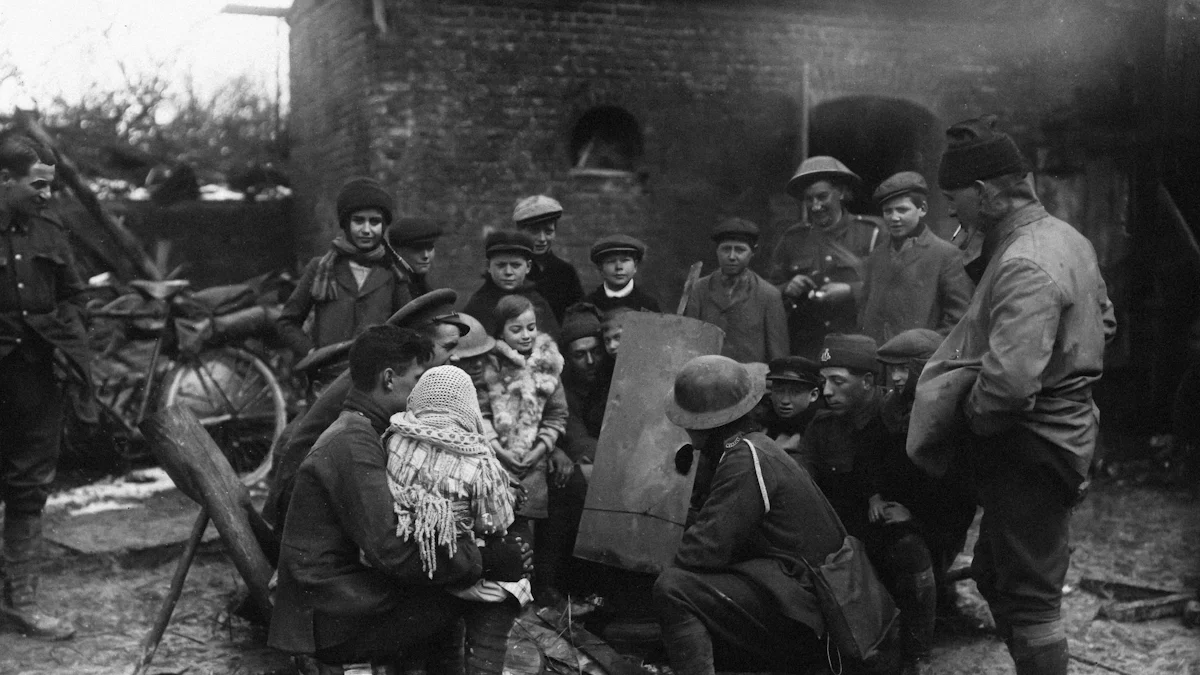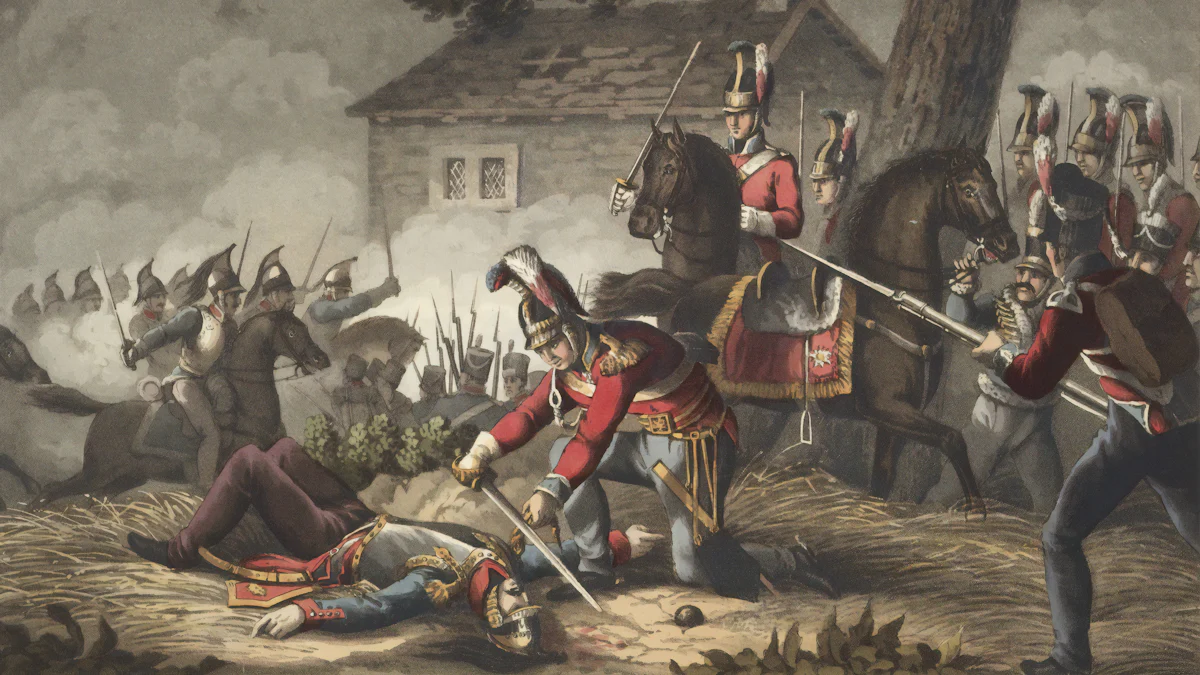World War I: The Definitive Visual History

World War I was a significant event in the annals of war and history. This monumental conflict saw the involvement of over 65 million individuals and resulted in the tragic loss of approximately 16 million lives, encompassing both soldiers and civilians. The war's far-reaching impact reshaped nations and economies worldwide, with countries such as Britain allocating 37% of their wartime national income. Visual history is essential in comprehending this period, as photographs and maps offer valuable insights into the experiences of those who endured the war. These visual elements help illustrate the vast scale and profound significance of World War I, providing a deeper understanding of its lasting legacy.
The Assassination of Archduke Franz Ferdinand
The Political Climate of Europe

Rising Tensions
Europe in the early 20th century faced growing tensions. Nationalism surged across various regions. Countries sought to expand their influence and power. The formation of alliances added complexity to international relations. The Triple Alliance included Germany, Austria-Hungary, and Italy. This alliance aimed to counteract French and Russian influence. Each member promised military support if attacked by two other powers.
Alliances and Entanglements
The Triple Entente formed as a response. France, Russia, and Britain joined forces. These alliances created a web of entanglements. A conflict involving one nation could easily escalate. The assassination of Archduke Franz Ferdinand became the catalyst. His death set off a chain reaction among these alliances.
The Event That Sparked the War
Details of the Assassination
On June 28, 1914, Archduke Franz Ferdinand visited Sarajevo. A nationalist group targeted him. Gavrilo Princip, a member of this group, carried out the assassination. The murder shocked Europe. Leaders scrambled to respond to the crisis.
Immediate Reactions
Austria-Hungary blamed Serbia for the assassination. Demands for justice led to ultimatums. Diplomatic efforts failed to ease tensions. Nations began mobilizing their armies. The assassination united the original Allied powers. Declarations of war followed swiftly. The conflict soon engulfed Europe, marking the beginning of World War I.
The Outbreak of War
Mobilization and Early Battles
The Schlieffen Plan
Germany devised the Schlieffen Plan to quickly defeat France. This strategy aimed to avoid a prolonged two-front war. The plan involved invading France through neutral Belgium. Germany believed this would lead to a swift victory. However, the plan faced significant challenges. Helmuth von Moltke, who succeeded Schlieffen, made crucial modifications. These changes weakened the original strategy. The invasion of Belgium drew Britain into the conflict. The plan's failure marked a turning point in World War I.
The Battle of the Marne
The Battle of the Marne became a decisive moment in history. French and British forces launched a counterattack. This action halted the German advance. The battle saved Paris from capture. The Allies forced the Germans to retreat. The Schlieffen Plan lay in ruins. The battle ensured that the war would continue. This marked the beginning of a long and grueling conflict.
Trench Warfare Begins
Life in the Trenches
Trench warfare defined much of World War I. Soldiers lived in harsh conditions. Mud, rats, and disease plagued daily life. Troops faced constant danger from enemy fire. The trenches stretched for miles along the Western Front. Soldiers endured long periods of boredom and fear. The living conditions took a toll on morale. Many soldiers suffered from shell shock.
Technological Innovations
World War I saw significant technological advancements. New weapons changed the nature of combat. Machine guns, tanks, and poison gas emerged. These innovations increased the war's lethality. Aircraft played a crucial role in reconnaissance. Artillery became more powerful and accurate. These technologies shaped the strategies used by both sides. The war's impact on military tactics remains evident in history.
Major Battles and Turning Points

The Battle of Verdun
Strategies and Outcomes
The Battle of Verdun became a symbol of French determination. German forces launched an offensive in February 1916. The goal focused on bleeding France white through attrition. French troops held strong defensive positions. The battle lasted for ten months. Both sides suffered heavy casualties. The French lost 377,000 men. The Germans lost 330,000 men. This created a manpower crisis for Germany. Verdun's defense boosted French morale. The battle demonstrated the importance of strategic resilience.
Personal Accounts
Soldiers at Verdun faced unimaginable horrors. Personal accounts reveal the brutal conditions. Mud and constant shelling defined daily life. Many soldiers experienced psychological trauma. Letters and diaries describe the fear and exhaustion. These personal stories highlight the human cost of war. The experiences at Verdun left lasting scars on those who survived.
The Battle of the Somme
Scale and Impact
The Battle of the Somme began in July 1916. Allied forces aimed to relieve pressure on Verdun. The offensive involved British and French troops. The first day saw 57,000 British casualties. The battle continued for five months. Over one million men were wounded or killed. The Somme taught valuable lessons to commanders. These lessons contributed to the eventual Allied victory in 1918. The battle marked a turning point in military tactics.
Visual Depictions
Visual depictions of the Somme capture its scale. Photographs show the devastation and destruction. Images of trenches and battlefields convey the harsh reality. Art and film portray the human suffering. These visuals provide insight into the war's impact. The imagery helps people understand the enormity of the conflict. Visual history plays a crucial role in preserving these memories.
The Home Front and Global Impact
Civilian Life During the War
Economic Changes
World War I reshaped economies across the globe. European nations faced severe disruptions. The war effort consumed vast resources. Governments increased taxes and borrowed heavily. Industries shifted to produce military goods. This shift led to shortages in consumer products. The United States emerged as a leading industrial power. American factories supplied essential materials to the Allies. The U.S. became the world's primary creditor.
Social Shifts
The war brought significant social changes. Millions of women joined the workforce. Women replaced men who went to fight. This shift altered traditional gender roles. New job opportunities arose for women. The war also spread the deadly Spanish flu epidemic. The pandemic claimed millions of lives worldwide. Social reforms gained momentum during this period. Workers demanded better conditions and rights. The war fostered a sense of self-consciousness among laborers.
The War Beyond Europe
Involvement of Colonies
Colonial territories played crucial roles in the war. European powers relied on their colonies for resources. Colonies provided soldiers and laborers. Many colonial troops fought on distant battlefields. The war ignited revolts in several colonies. Nationalist movements gained strength. Colonies sought independence from imperial rule. The conflict highlighted the inequalities of colonialism.
Global Repercussions
World War I had far-reaching political consequences. The war led to the downfall of four monarchies. The Bolsheviks rose to power in Russia. The United States emerged as a global power. New technologies changed warfare forever. The war set a precedent for government involvement in society. Nations learned valuable lessons from the conflict. These lessons shaped future international relations.
The End of the War and Its Aftermath
The Armistice and Treaty of Versailles
Terms and Conditions
The Armistice of November 11, 1918, marked the cessation of hostilities in World War I. Germany agreed to withdraw troops from occupied territories. Allied forces demanded the surrender of military equipment. The Treaty of Versailles, signed on June 28, 1919, formalized peace terms. The treaty imposed severe penalties on Germany. Germany lost significant territories to neighboring countries. The treaty required Germany to disarm and limit its military capabilities. Reparations payments burdened Germany's economy. The War Guilt clause held Germany responsible for the conflict.
Political Reactions
The Treaty of Versailles sparked widespread political reactions. Many Germans viewed the treaty as humiliating. The treaty fueled resentment and anger among the German population. Political instability increased in Germany. The harsh terms contributed to economic hardship. Adolf Hitler and the Nazi Party capitalized on public discontent. The treaty failed to address underlying issues that led to war. Many historians consider the treaty a factor in the rise of World War II.
Legacy and Commemoration
Memorials and Remembrance
World War I left a lasting legacy on global history. Nations built memorials to honor those who served. Monuments and cemeteries commemorate the fallen soldiers. Annual ceremonies mark the anniversary of the armistice. Countries observe moments of silence to remember the war's impact. These acts of remembrance foster a sense of unity and reflection.
Lessons Learned
World War I taught valuable lessons to future generations. The conflict highlighted the dangers of nationalism and militarism. Diplomacy and cooperation became essential for peace. The League of Nations formed to prevent future conflicts. The war underscored the importance of addressing grievances peacefully. Historians study the war to understand its causes and consequences. These lessons continue to shape international relations today.
World War I left a profound impact on modern history. The war reshaped nations and altered political landscapes. The lessons from this conflict emphasize the importance of diplomacy. Understanding the causes and effects of the war helps prevent future conflicts. Commemorating those who served fosters a sense of unity. Memorials and ceremonies honor the sacrifices made during the war. Educating future generations about World War I ensures that history's mistakes are not repeated. The study of this war provides valuable insights into the complexities of global relations.
See Also
Battle: The Ultimate Illustrated Chronicle
Revolutionary America: An Illustrated Journey
Armed Forces Chronicles: The Ultimate Visual Reference

